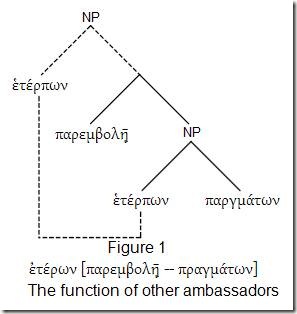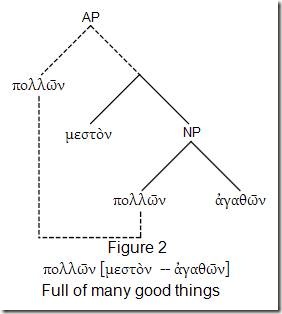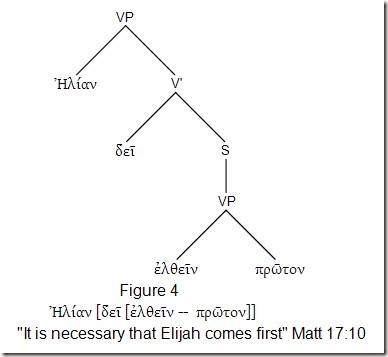Discontinuous Syntax in the New Testament
A Condensation, Summary and Application of
Discontinuous Syntax: Hyperbaton in Greek
by A. M. Devine and Laurence D. Stephens.
Oxford University Press, USA, 2000.
1. Introduction
The following discussion seeks summarize and distill the basic thesis of A. M. Devine and Stephen’s Discontinuous Syntax: Hyperbaton in Greek (henceforth “DS,” which conveniently is also the authors’ initials). The vast majority of it has been rewritten in the my own words and, where possible, uses examples from the New Testament and other Hellenistic Literature. Throughout the discussion, I’ve generally maintained the book’s theoretical slant. But this does not imply acceptance of a transformational understanding of generative grammar. Devine and Stephen’s work focused specifically on Classical Greek, thus this summary also functions as a test to determine whether their proposed structures continue to represent the same or similar pragmatic meanings argued in their book.
The issue at hand is helpfully described on the inside of the front cover,
The most immediately obvious different between Greek and English Syntax is free word order, and phrasal discontinuity is the starkest manifestation of free word order. What sort of syntactic typology, one wonders could license sentences like A red he bought shirt and A shirt he bought red, and what semantic or pragmatic meanings do such word orders convey? … More important than its pervasiveness is its theoretical significance: in many ways, phrasal discontinuity is the key to understanding how the whole system of Greek syntax works and how it has evolved over time.
Devine and Stephen’s work is incredibly important for the study of Greek syntax. Unfortunately, their prose is dense and highly technical, making it difficult reading for those Greek scholars and students who have not been introduced to formal syntax.[1]
The book itself consists of six chapters, each one building on the previous. The result of this is that a given analysis in an earlier chapter may not be accepted later, or more accurately, its acceptability is qualified by other factors later on in the book. Chapter one functions as an introduction surveying the large number of phrasal categories in which discontinuity appear. Chapter two focuses on describing the meaning of this discontinuity in prose with a description of various types of focus. Following that, the third chapter examines variations on the pattern and their potential meanings. Chapter four seeks to determine exactly what licenses discontinuous phrases in Greek concluding that Greek cannot have a completely flat structure, particularly in the Verb Phrase, otherwise there would be no syntactic account for the difference in meaning between a focus structure and a non-focused structure. And after chapter five, which discusses prosody in Greek, the finally chapter proposes a unified overarching theory for the structure of Classical Greek syntax.
Of course, the major question at hand is whether the model for Classical Greek proposed by Devine and Stephens also works just as well for Koine. What follows below seeks to both summarize Devine and Stephen’s claims in the most relevant chapters and determine the extent of their applicability to the Greek found in the New Testament and other Koine documents.[2]
2. Y1 Hyperbaton in Prose
The term “Y1 Hyperbaton” is the label DS give to the discontinuous structure: where a given phrase of any type, labeled YP has been split in half by another phrase, XP resulting in the structure [Y1 XP Y2]. Specifically, when the modifier of the YP appears first in the hyperbaton, the structure is called “Y1 Hyperbaton,” while if the modifier appears last, they use the term “Y2 Hyperbaton.” The use of the labels, “Y” and “X” is justified by DS’s claim that this structure appears across all phrase types. Thus, “YP” and “XP” represents phrasal constituents of any category, a claim that is examined below.
2.1 Crosscategorial Analysis
2.1.1 Noun Phrase Hyperbaton
The basic structure of NP hyperbaton provided by DS is shown in figure 1 below. They derive their example from Aeschines 3.205[3]
Searching Koine texts provides in a number of examples, show in examples (1) and (2) from the New Testament an Apostolic Fathers. Instances also appear in Philo
(1) θείας κοινωνοὶ φύσεως
“participant in the divine nature.” 2 Peter 1:4
(2) ἀνθρωπίνων οἰκονομίαν μυστηρίων
“the administration of human mysteries.” Diogenes 7.1
In the New Testament, we find 2 Peter 1:4 θείας κοινωνοὶ φύσεως “participant in the divine nature.” [4] In the Apostolic Fathers, Diogenes 7.1, we have ἀνθρωπίνων οἰκονομίαν μυστηρίων, “the administration of human mysteries.” DS provides examples of hyperbaton in Noun Phrases where the NP is assigned a number of different grammatical relations.
2.1.2 Adjective Phrase Hyperbaton
DS’s example of AP hyperbaton is seen in figure 2 and is derived from Plato’s Laws 906a.
“This is a simple adjective phrase hyperbaton, in which the head and its sister noun phrase constituent exhaust the adjective phrase…. The genitive can be a complement genitive, a partitive genitive, or a genitive of comparison; the adjective can be a null head modifier.[5] Philo’s writings are full of examples of this structure, as seen in examples (1) and (2)
(3) τὸ πάντων ἄριστον ἐσθημάτων
“the best clothing of all” Sacrifices §83
(4) παντὸς τιμιωτέρᾳ χρυσοῦ
“the most precious of all gold.” Drunkenness §86
2.1.3 Verb Phrase Hyperbaton
Their example of VP hyperbaton is form Demosthenes 3.13
Verb Hyperbaton is one of the more common patterns in the New Testament.
(5) ὅλη συγχύννεται Ἰερουσαλήμ
“All Jerusalem was in confusion” Acts 21:31
(6) πολλοὶ δὲ ἔσονται πρῶτοι ἔσχατοι
“Many who are first will be last.” Mark 10.31
2.1.4 Missing Hyperbaton Categories
A number of things should be noted regarding the phrasal categories in which hyperbaton appears. For one, while DS provide evidence of hyperbaton occurring in prepositional phrases in Classical Greek, this form does not occur in the Koine texts searched. The fact that the structure is not found does not necessary negate its existences in the Koine period. This is because even in the analysis of DS, the structure PP à Y1 P Y2 only occurs in poetry. “The common verse practice of wrapping a noun phrase around its prepositional head is … illicit in prose…. Since NPN is illicit, it follows that NVPN should not occur either.[6]
2.1.5 Extra Hyperbaton Categories
There is also one type of hyperbaton that does not appear in DS, though it does likely appear in Classical Greek. Non-verbal clauses can also contain hyperbaton between the nominal predicate and the NP[subj]. This is seen in the example below.
(7) ταλαίπωρος ἐγὼ ἄνθρωπος
“I am a wretched man.” Romans 7:24
This is technically not Noun Phrase hyperbaton because in a continuous phrase construction the mother node of both of these NP’s would be the sentence rather than an NP, thus the head of the hyperbaton structure is not the NP[subj], but the sentence.
2.1.6 Intervening Constituents
One final observation can be made regarding Adjective Initial (Y1) Hyperbaton. DS notes that there are times when an extra argument or adjunct appears between their Y1 and Y2, which they refer to as a ZP, since both XP & YP have already been used. The result of this is more complex than other forms of hyperbaton. This ZP unit can appear in a variety of places within the structure:
ZP Y X Y
Y ZP X Z
Y X Y ZP
Y X ZP Y
Ds provide no representation of the structure of these, but there is at least one example of this occurring ZP in the New Testament.[7]
(8) δευτέραν ὑμῖν γράφω ἐπιστολήν
“I write a second letter to you” 2 Peter 3:1
Here there is another NP with the Verb occurring between the Y1 modifier and its head noun.
It’s also possible for hyperbaton to go beyond the confines of the XP. [Update: I’ll be looking for a better example of this. I miss read the text] This is seen in example (9).
(9) Ἠλίαν δεῖ ἐλθεῖν πρῶτον
“It is necessary that Elijah come first” Matt 17:10
Essentially, the Y1 constituent in (9), rather than appearing in the specifier position of the XP as it was above, appears in the specifier position of a superordinate phrase, a phrase that does not immediately dominate what would normally be the NP [Ἠλίαν πρῶτον] This can be better shown in Figure 4.[8]
To say this in English, the specifier position of a constituent is the branch of a tree to the right of its phrasal head. In Figure 4, Ἠλίαν is in the specifier position of the higher level Verb Phrase, which has δει as its head. This verb on the basis of its lexical semantics requires an infinitive complement clause, which is represented by “S.”[9] This complement clause contains a VP with its Verb head ἐλθεῖν. The other half of what would be a normal Noun Phrase, πρῶτον, appears in the complement position of this lower VP.
2.1.7 Conclusions
We have seen previously that hyperbaton is a large phenomenon that covers all phrase categories. This suggests a few things. For one, such consistency across phrasal categories (NPs, VPs, etc) suggests that Greek is more configurational than some would claim.[10] This is not to say that Greek is as configurational as English, only that the language is still highly structured. Secondly, more likely than not its meaning, whether semantic or pragmatic, will prove to be relatively consistent, something that DS shows in their discussion of Restrictive or Contrastive Focus, though, as will be seen, this is not the whole story. Surveying DS’s discussion of Focus will be the focus of part II.
[1] It should also be noted that the book is rather unhelpful for the majority of linguists as well. While there is a literal interlinear translation provides in the back of the book, it is generally less usable than those seen in most linguistic works, making the book less than accessibly for the non-Hellenic linguist.
[2] Specifically, the Koine texted used include the LXX, the Apostolic Fathers, the New Testament, and the Works of Philo.
[3] DS, 11. The translation is theirs. Also, figure one, borrowed from DS, 11 suggests that the authors follow a Transformational-Generative framework. Discussing the validity of such an approach is not the focus on this paper, though proposals will be made at the end for a representation of hyperbaton without movement.
[4] It could be argued that this is hyperbaton in an AP. Some morphological databases tag κοινωνός as an adjective and others tag it as a noun.
[5] Ibid. It should be noted that the question of null heads is a issue very much open to debate amongst syntactic theorists. At the present the purpose is merely to summarize and present the view of DS and provide evidence from the Koine period rather than debate the existence of null heads of any kind.
[6] DS, 17.
[7] There are likely to be many more but such structures are very difficult to location in today’s databases. The example shown in (8) was actually provide for me by Dr. Micheal Palmer in a personal correspondence.
[8] This is my attempt at helpful explanation and illustration. Nothing like this diagram appears in this chapter of DS, which is why no movement is represented.
[9] Another common label for complement clauses in much generative syntax is CP, which stands for “Complement Phrase.”
[10] E.g. Stanley E. Porter and Andrew W. Pitts, “New Testament Greek Language and Linguistics in Recent Research,” Currents in Biblical Research 2008; 6:214-255; see especially 232-33, though Porter and Pitts are aware of the existence of DS, they give no recognition of the book’s work in showing to what extent Greek is configurational.



